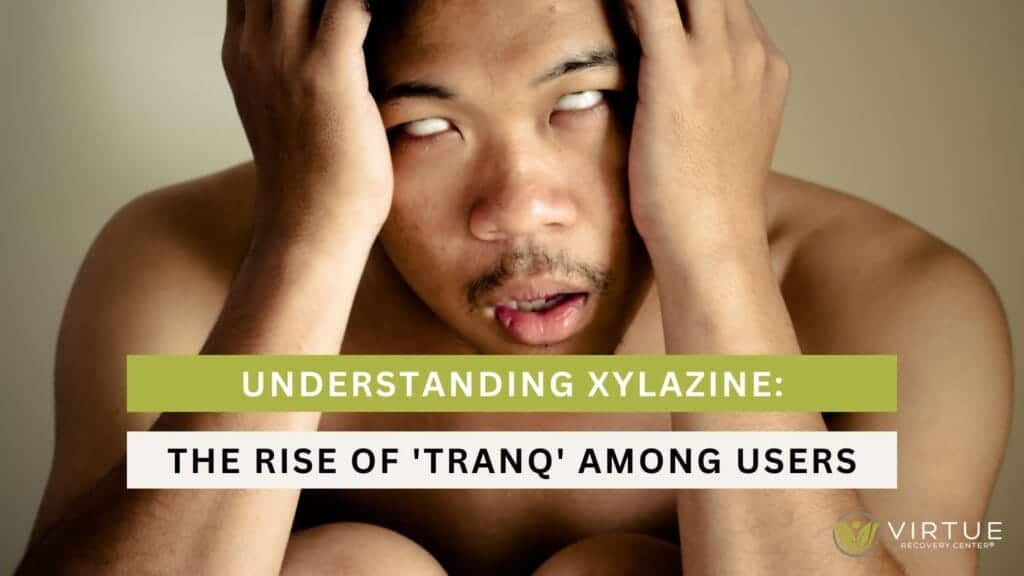Xylazine, a tranquilizer drug originally intended for veterinary use, has recently emerged as a significant concern within the U.S. illegal drug supply, often being linked with the troubling rise of ‘fentanyl zombies’ due to its hazardous effects when mixed with opioids like fentanyl. Despite its classification as a non-opioid and its lack of approval for human use, xylazine has been found in nearly 80% of opioid samples from certain syringe service programs between 2021 and 2022, showcasing its alarming prevalence. Known colloquially as ‘tranq’ or ‘tranq dope,’ its escalating presence indicates a concerning trend among new street drugs, contributing to an increase in overdose deaths and complex challenges like xylazine withdrawal and xylazine effects including possible necrosis.
With xylazine now infiltrating every region of the United States from 2020-2021, the situation demands a closer examination of its role not just as a ‘horse tranquilizer’ but as a key player in opioid use disorder and the broader opioid crisis. This article aims to shed light on what is tranq, the unique risks posed by this ‘zombie drug,’ and the urgent efforts required to address this emerging threat. By understanding the nuances of xylazine’s impact, from xylazine wounds to its contribution to polysubstance use, readers can grasp the severity of its infiltration into the drug market and the critical response needed to combat its spread.
Understanding Xylazine
Xylazine, primarily known as a veterinary tranquilizer, has increasingly found its way into the illicit drug market, posing significant health risks when used by humans. This non-opioid sedative, also referred to as “tranq,” is not approved for human use but has been detected in various illegal drug mixtures, particularly with opioids like fentanyl, which can exacerbate its already dangerous effects.
Characteristics and Mechanism
Xylazine acts as a central nervous system depressant through its action as an alpha-2 receptor agonist. It inhibits the release of norepinephrine, leading to effects such as hypotension, bradycardia, sedation, analgesia, and muscle relaxation. These pharmacological actions explain why xylazine can cause severe drowsiness, amnesia, and significantly slow down breathing, heart rate, and blood pressure, which can be life-threatening.
Detection and Challenges
One of the significant challenges in addressing xylazine-related incidents is its detection. Xylazine is not included in routine immunoassay toxicology screens, which leads to its frequent under-detection. Moreover, even with appropriate testing, xylazine might not be detected due to its rapid elimination from the body, with a half-life of only 23-50 minutes, complicating medical responses to overdoses. Additionally, there is no approved antidote for xylazine poisoning in humans, and naloxone, the opioid reversal medication, does not reverse the effects of xylazine, further complicating treatment efforts for those experiencing an overdose.
Effects of Xylazine on Users
Immediate Physical Effects
- Respiratory and Cardiovascular Impact: Xylazine significantly depresses the central nervous system, leading to severe respiratory depression and cardiovascular issues such as bradycardia and hypotension. These effects are exacerbated when xylazine is combined with other central nervous system depressants like alcohol or benzodiazepines.
- Risk of Overdose: The sedative properties of xylazine can lead to dangerously low breathing, heart rate, and blood pressure, increasing the risk of coma or death, particularly when used with opioids.
- Skin and Soft Tissue Infections: Repeated use of xylazine is linked to severe skin ulcers and abscesses, which often begin as blackened eschars and can progress to extensive necrotic wounds requiring significant medical intervention.
Long-term Health Consequences
- Chronic Wounds and Ulcers: Long-term users of xylazine often suffer from chronic wounds and ulcers, which are difficult to treat due to the drug’s vasoconstricting effects that decrease blood flow and oxygenation to tissues.
- Cumulative Toxic Effects: Prolonged use of xylazine can lead to cumulative toxic effects on various organ systems, manifesting as chronic complications that may require ongoing medical care.
- Dependency and Withdrawal: Users may develop a physical dependence on xylazine, experiencing severe withdrawal symptoms that can be more intense than those from opioids, complicating the treatment and recovery process.
Challenges in Medical Response
- Detection and Treatment: Xylazine is not routinely detected in standard drug screening tests, making it difficult to diagnose and treat overdoses effectively. Furthermore, there is no approved antidote for xylazine poisoning, and while naloxone may reverse opioid effects, it does not counteract xylazine toxicity.
- Management of Overdose: Medical professionals must be prepared to use alternative treatments to manage symptoms of xylazine overdose, such as medications for low blood pressure and heart rate, due to the ineffectiveness of standard overdose-reversing antidotes.
- Withdrawal Management: Managing withdrawal symptoms from xylazine requires careful medical supervision, as the syndrome can include severe hypertension, anxiety, and restlessness, which are often managed concurrently with opioid withdrawal.
Xylazine’s Role in the Opioid Crisis
Xylazine, often combined with opioids like fentanyl, significantly exacerbates the opioid crisis by increasing the potency and duration of the drugs’ effects. Users report adding xylazine to fentanyl to extend its euphoric impact. However, this combination poses severe risks, as evidenced by the substantial presence of xylazine in opioid samples across various regions. For instance, nearly 80% of opioid samples tested in Maryland between 2021 and 2022 contained xylazine. This alarming trend is not isolated; in Philadelphia, 31% of heroin and/or fentanyl overdose deaths in 2019 involved xylazine.
The dangers of xylazine in the opioid crisis are further highlighted by its contribution to overdose deaths. In 2020, xylazine was involved in nearly 7% of drug overdose deaths across ten U.S. cities. The following year saw a significant increase, with xylazine detected in almost 80% of opioid samples in Maryland, indicating a disturbing rise in its use. This surge is part of a broader national trend where xylazine’s presence in illicit drug markets has grown, particularly in the Northeast, where overdose deaths linked to xylazine jumped from 2% in 2015 to 26% in 2020.
Moreover, xylazine complicates medical responses to overdoses. It is not an opioid, and thus, naloxone, the standard treatment for opioid overdose, does not reverse its effects. This presents new challenges in overdose response, as xylazine can cause severe respiratory depression and increase the risk of fatal overdose when combined with opioids. The White House Office of National Drug Control Policy has recognized the gravity of this issue, declaring fentanyl adulterated with xylazine as an emerging drug threat and highlighting the need for adapted response strategies.
Rise of ‘Tranq’ in the Illicit Drug Scene
User Preferences and Public Health Warnings
The presence of xylazine in street drugs varies in user reception. Some users specifically seek out heroin or fentanyl-laced with xylazine for its extended effects, while others actively avoid it due to its potential to reduce euphoria and increase the risk of adverse reactions. This split in user preference complicates efforts to address the use of ‘tranq’ and underscores the need for targeted public health interventions. Additionally, health departments in major cities like Los Angeles have issued warnings about the dangers of xylazine in the opioid scene, indicating its significant infiltration into the drug market.
Detection in Major Cities
Recent findings have confirmed the presence of xylazine in opioid samples from cities such as San Francisco and San Diego. This indicates not only the widespread nature of xylazine use but also the pressing challenge it poses to health authorities trying to curb its spread. The detection of xylazine in these areas signals a critical need for enhanced surveillance and public health response to manage the implications of this emerging drug threat.
Rise of Xylazine in the Illicit Drug Market
The infiltration of xylazine into the illicit drug market presents a multifaceted challenge, characterized by its low cost, increasing presence in polydrug mixtures, and significant impact on public health. Here, we explore the factors contributing to the rise of xylazine and its implications.
Economic Attractiveness and Geographic Spread
- Cost-Effectiveness for Traffickers: Xylazine’s low purchase price from online suppliers, primarily in China, makes it an economically attractive adulterant for drug traffickers. This affordability allows traffickers to enhance the potency of other drugs like fentanyl at a low cost, thereby increasing their profit margins.
- Widespread Use Across the U.S.: The detection of xylazine in drug samples has shown a marked increase across all four U.S. census regions from 2020 to 2021. This geographic spread is indicative of the drug’s growing role in the national illicit drug scene, compounding the challenges faced by health and law enforcement agencies.
Public Health Impact and Legal Challenges
- Increased Fatal Overdoses: Xylazine has been increasingly found in combination with fentanyl, contributing to a higher potential for fatal overdoses due to its capacity to depress respiratory functions further. In Philadelphia alone, the percentage of drug overdose deaths involving xylazine jumped from 2% in 2015 to 26% by 2020.
- Challenges in Detection and Regulation: Despite its growing presence, xylazine is not routinely included in toxicological screenings, and there is no comprehensive data on xylazine-positive overdose deaths due to varied testing and reporting practices across jurisdictions. This lack of consistent detection and monitoring complicates efforts to gauge the full scope of its impact and to formulate effective regulatory responses.
Response to the Emerging Threat
- National and Regional Strategies: In response to the escalating threat, the White House’s Office of National Drug Control Policy has declared fentanyl mixed with xylazine as an emerging drug threat and released a National Response Plan on July 11, 2023. This plan aims to address the complexities introduced by xylazine in the ongoing opioid crisis and to coordinate efforts across states and agencies.
- Development of Detection Tools: To improve the response to xylazine-related incidents, efforts are underway to develop and distribute xylazine test strips for drug checking, which could play a crucial role in harm reduction strategies across various states.
The rise of xylazine in the illicit drug market underscores a critical need for coordinated public health and law enforcement strategies to address this dangerous trend. Understanding its economic drivers, health impacts, and the challenges in its detection and regulation will be essential for developing effective interventions as xylazine continues to spread.
Risks of Polysubstance Use Involving Xylazine
Interactions with Other Central Nervous System Depressants
- Increased Overdose Risk: Combining xylazine with central nervous system depressants such as alcohol or benzodiazepines significantly heightens the risk of a life-threatening overdose. This is due to the compounded depressant effects, which can severely impair respiratory and cardiac functions.
- Exacerbation of Respiratory Depression: When xylazine is mixed with opioids like fentanyl, the risk of fatal overdose escalates due to the enhanced respiratory depression. This combination can lead to dangerously low breathing rates, increasing the likelihood of coma or death.
- Complexity in Clinical Diagnosis and Response: The presence of xylazine in polydrug use scenarios complicates medical diagnosis and response, as its detection is not included in routine drug screening tests. This often leads to underdiagnosis and delays in appropriate medical intervention during overdoses.
Compounding Effects of Illicit Opioids
- Enhancement of Euphoric Effects: Users often add xylazine to fentanyl to prolong the euphoria associated with opioid use, which can mislead users about the amount of drugs consumed and increase the risk of overdose.
- Public Health Challenges: The combination of xylazine with synthetic opioids like fentanyl not only increases the potency but also the duration of effects, posing significant challenges in managing public health responses to drug overdoses.
Broad Spectrum of Polysubstance Interactions
- Diverse Drug Combinations: Overdose deaths involving xylazine and fentanyl frequently include other substances such as cocaine, heroin, benzodiazepines, alcohol, gabapentin, methadone, and prescription opioids. These combinations can unpredictably alter the effects of xylazine, complicating treatment protocols and increasing the risk of severe outcomes.
- Long-term Health Consequences: Repeated use of xylazine in combination with other drugs can lead to severe health issues such as skin ulcers, abscesses, and potentially life-threatening infections like sepsis.
Efforts to Combat the Xylazine Crisis
Public Health Initiatives and Harm Reduction Strategies
- Public Education and Community Outreach: To mitigate the risks associated with xylazine, public health departments, and community-based organizations are intensifying efforts to educate the public about its dangers. These entities focus on the symptoms of xylazine use and how to respond to suspected xylazine-related injuries and overdoses. Additionally, harm reduction organizations are providing crucial messaging about the changing drug supply and the risks associated with exposure to potent opioids like fentanyl mixed with xylazine.
- Healthcare Provider Engagement: Healthcare professionals are encouraged to discuss the evolving illegal drug supply with patients, emphasizing the increased risks of overdose and exposure to potent substances like fentanyl and xylazine. They are also advised to inform patients that naloxone does not reverse the effects of xylazine, highlighting the importance of calling 911 in the event of an overdose involving this combination.
- Enhanced Detection and Response Tools: The development and distribution of point-of-care drug-checking technologies, including xylazine test strips, are crucial in identifying the presence of xylazine in the unregulated drug supply. These tools aid in preventing overdoses by allowing users and healthcare providers to detect xylazine and respond appropriately.
Policy and Regulatory Efforts
- Federal and State Actions: The Biden-Harris Administration has announced new measures focusing on expanding access to life-saving medications and reducing the stigma associated with opioid use disorder treatment. These actions include updating regulations for Opioid Treatment Programs (OTPs) and approving federal grant funds for the purchase of xylazine test strips to enhance overdose prevention efforts.
- Support for Harm Reduction Services: There is a strong push to support the development and scale-up of harm reduction services. This includes expanding community-based naloxone distribution and educating individuals about the risks of polysubstance use. Efforts are also underway to reduce barriers to accessing medication for opioid use disorder in various settings, such as mobile clinics and emergency departments.
Strengthening Healthcare System Capacity
- Comprehensive Public Health Guidelines: To address the xylazine crisis effectively, there is an urgent need for harm reduction-informed public health guidelines. These guidelines aim to promote a safer drug supply, strengthen the capacity of healthcare systems to prevent and respond to overdoses and address social and structural disparities in health outcomes.
- Toolkit and Resource Distribution: The Substance Abuse and Mental Health Services Administration (SAMHSA) has released an updated Overdose Prevention and Response Toolkit. This resource provides guidance on preventing overdoses and responding to stimulant or opioid overdoses, offering tailored advice for various populations.
Challenges in Overdose Prevention and Treatment
Ineffectiveness of Naloxone Against Xylazine
- Naloxone Limitations: Naloxone is the standard emergency medication for reversing opioid overdoses, but it does not effectively counteract xylazine, which complicates treatment protocols when the two are used together. While naloxone can reverse the opioid effects, it does not mitigate the respiratory depression caused by xylazine, making it less effective in these scenarios.
- Dual Administration Recommendations: Despite its limitations with xylazine, naloxone is still recommended in cases of suspected xylazine overdoses because of the high likelihood that opioids are also involved. However, this requires healthcare providers to manage symptoms that naloxone cannot alleviate, such as severe respiratory depression caused by xylazine.
Diagnostic and Management Challenges
- Complexity in Clinical Diagnosis: Identifying xylazine in overdose cases is challenging in clinical settings due to its absence in routine toxicology screens. This often leads to underdiagnosis or misdiagnosis, complicating the effective management of overdose cases.
- Lack of a Reversal Agent: Currently, there is no approved antidote for xylazine poisoning in humans, which means that treatment is generally limited to supportive care, such as rescue breathing and managing other life-threatening symptoms.
Communication and Public Health Strategies
- Educating Healthcare Professionals: It is crucial to inform and educate healthcare professionals and first responders about the potential for xylazine exposure in overdose scenarios, especially in cases where naloxone fails to reverse the symptoms effectively.
- Public and Community Outreach: Communicating the risks and trends associated with xylazine to those who use drugs and their communities is vital. This includes educating on safer drug use practices and the importance of incremental dosing to mitigate the risk of overdose.
Conclusion
The alarming rise of xylazine, or ‘tranq’, within the illicit drug market represents a complex challenge that exacerbates the ongoing opioid crisis, posing significant public health risks and complicating overdose prevention and treatment efforts. This comprehensive exploration illustrates not only the dangerous physical effects of xylazine when combined with opioids like fentanyl but also underscores the need for heightened awareness, improved detection methodologies, and a coordinated response among healthcare providers, law enforcement, and public health officials. Central to addressing this crisis is an emphasis on expanding access to treatment for those affected, underscoring the critical nature of timely intervention and support from trusted healthcare facilities like Virtue Recovery Center.
Understanding xylazine’s impact invites a broader discussion on the importance of addressing polysubstance use and its implications for individuals and the community at large. The efforts to combat this crisis, including the development of harm reduction strategies and the provision of comprehensive treatment modalities, are essential in mitigating the adverse effects experienced by users. As we navigate these challenges, the role of specialized care centers becomes increasingly paramount in providing hope and a path to recovery for those ensnared in the grip of addiction. For those seeking to reclaim their lives from the clutches of substance use, reaching out for professional support can be the first step toward transformation. Call Virtue Recovery Center if you or a loved one is ready to start the journey to recovery at 866-461-3339.
FAQs
What should be administered in case of a xylazine overdose?
In situations where a xylazine overdose is suspected, it is advised to administer naloxone, the opioid overdose reversal medication. This is because xylazine is often mixed with opioids, making naloxone effective in these cases.
What are Xylazine wounds?
Xylazine wounds occur due to the drug‘s severe vasoconstrictive effects, which reduce blood flow to certain areas, potentially leading to tissue damage and necrosis. These wounds are often deep, difficult to heal, and can lead to severe infections.
What are the symptoms of xylazine withdrawal?
Symptoms of xylazine withdrawal can include severe anxiety, tremors, increased heart rate, high blood pressure, and agitation. Due to its sedative properties, sudden cessation may lead to heightened sensory sensitivity and excitability.
Why is xylazine referred to as tranq?
Xylazine is often called “tranq” short for tranquilizer, due to its primary use in veterinary medicine to sedate animals. Its calming, sedative effects led to its street name.
Why is xylazine referred to as the zombie drug?
Xylazine is dubbed the “zombie drug” because of its profound sedative effects, which can leave users in a zombie-like, stuporous state, significantly impairing mobility and awareness.
Does xylazine cause necrosis?
Yes, xylazine can cause necrosis. The drug’s ability to significantly reduce blood flow to extremities can lead to tissue death, resulting in severe necrotic wounds.
How do you pronounce Xylazine?
Xylazine is pronounced as “ZAI-luh-zeen”.
What are the side effects of Xylazine?
Side effects of xylazine include respiratory depression, bradycardia, hypotension, excessive sedation, and in severe cases, necrosis of the skin at injection sites.
Is Xylazine a controlled substance?
As of now, xylazine is not classified as a controlled substance at the federal level in the United States, but it is regulated in some states due to its misuse.
What is the class of drug Xylazine is?
Xylazine is classified as a sedative and a muscle relaxant, commonly used in veterinary medicine.
What is the mechanism of action for Xylazine?
Xylazine acts primarily as an alpha-2 adrenergic receptor agonist. It inhibits the release of norepinephrine, leading to sedation, muscle relaxation, and analgesia, primarily used to sedate animals during procedures.
What Are the Risks of Using Xylazine as a Synthetic Drug?
Xylazine, a synthetic drug commonly used as a veterinary anesthetic, poses numerous risks when abused by humans. Given its potent sedative and respiratory depressant effects, the dangers of xylazine as a recreational drug are significant. Seizures, coma, and even death can result from its misuse. Learn more about the dangers of synthetic drugs.
References
https://www.cdc.gov/drugoverdose/deaths/other-drugs/xylazine/faq.html
https://www.dea.gov/alert/dea-reports-widespread-threat-fentanyl-mixed-xylazine
https://nida.nih.gov/research-topics/xylazine
https://www.dea.gov/sites/default/files/2022-12/The%20Growing%20Threat%20of%20Xylazine%20and%20its%20Mixture%20with%20Illicit%20Drugs.pdf
http://publichealth.lacounty.gov/sapc/docs/public/overdose-prevention/XylazineLACounty.pdf
https://www.health.ny.gov/publications/12044.pdf
https://www.ncbi.nlm.nih.gov/books/NBK594271/
https://www.nih.gov/news-events/news-releases/xylazine-appears-worsen-life-threatening-effects-opioids-rats
https://www.health.ny.gov/statistics/opioid/data/pdf/nysdoh_op_dta8.pdf
https://www.ncbi.nlm.nih.gov/pmc/articles/PMC10370501/
https://www.cdph.ca.gov/Programs/CCDPHP/sapb/CDPH%20Document%20Library/Issue-Brief-Xylazine_ADA.pdf
https://www.nyc.gov/assets/doh/downloads/pdf/basas/xylazine-faq.pdf
https://oasas.ny.gov/xylazine
https://www.mayoclinic.org/diseases-conditions/drug-addiction/in-depth/xylazine/art-20559909
https://www.aafp.org/pubs/afp/afp-community-blog/entry/opioid-epidemic-updates-frankenstein-opioids-and-xylazine-induced-skin-ulcers.html
https://www.ncbi.nlm.nih.gov/pmc/articles/PMC10544173/
https://harmreductionjournal.biomedcentral.com/articles/10.1186/s12954-023-00867-x
https://www.ncbi.nlm.nih.gov/pmc/articles/PMC10498612/
https://www.cbsnews.com/losangeles/news/xylazine-public-health-warns-residents-about-new-drug-raising-risk-of-overdose/
https://www.dea.gov/documents/2022/2022-12/2022-12-21/growing-threat-xylazine-and-its-mixture-illicit-drugs
https://www.hhs.gov/about/news/2024/02/01/biden-harris-administration-marks-two-years-advancements-hhs-overdose-prevention-strategy-new-actions-treat-addiction-save-lives-press-release.html








